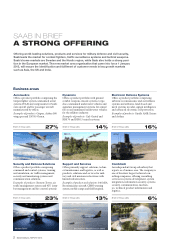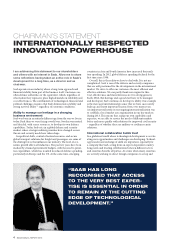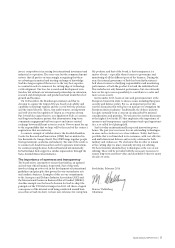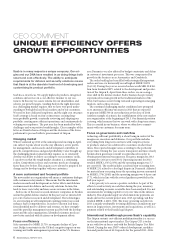Saab 2013 Annual Report Download - page 16
Download and view the complete annual report
Please find page 16 of the 2013 Saab annual report below. You can navigate through the pages in the report by either clicking on the pages listed below, or by using the keyword search tool below to find specific information within the annual report.
12 SAAB ANNUAL REPORT 2013
CENTRAL AND SOUTH AMERICA
Central America has had among the lowest defence spending in the
world in terms of percentage of GDP. However, the trend of decreased
or unchanged defence spending has been broken in recent years. The
reason is that the region’s defence forces, along with internal security
forces, have been involved in the ght against drug cartels and organ-
ised crime groups.
South America’s defence spending has increased in recent years. This
trend is apparent in better quality of the armed forces since defence
spending is rising faster than troop size.
Brazil accounts for approximately half of the region’s defence spend-
ing and has the ambition and resources to develop a diversi ed
defence industry. According to IHS Jane’s Defence & Security, Brazil’s
defence spending will increase by approximately 3 per cent annually
the coming years.
Share of global defence spending in 2013 4%
USA AND CANADA
The USA and Canada accounted for approximately 39 per cent of
the world’s total defence spending in 2013, according to IHS Jane’s
Defence & Security. The US defence budget alone accounted for 38.6
per cent of global defence spending, which is a decrease from the
year before.
The defence budget in the US is expected to decrease the coming
year and reach a low point in 2015 when a large decrease of overseas
contingency operations, for example operations in Afghanistan, is
planned. After that the defence budget is estimated to be at or even
show a slight increase. In Canada, the defence budget is expected to
decrease in coming years.
The US will nevertheless continue to have the largest defence ex-
penditure globally.
Share of global defence spending in 2013 39%
MARKETS
COMPLEX ENVIRONMENT
REQUIRES EFFICIENT SOLUTIONS
Being able to equip the military with modern defence platforms and technologies
requires resources. A number of Western countries are cutting their defence
budgets, which increases the need for cost-effective products and solutions.
Meanwhile, the demand remains for interoperable systems for participation in
international interventions.
EUROPE
Customers in Western Europe are reducing their defence spending
somewhat due to the economic downturn in Europe. Most countries
in the region are restructuring their armed forces in order to reduce
their organisations and create scope to continue to modernise their
equipment.
Many countries in Central and Eastern Europe still need to acquire
new equipment for their armed forces in order to enhance their abil-
ity to collaborate with, and contribute to, NATO. As the EU expands
eastward there is an increasing need to secure the ow of goods and
people and to protect the new external borders of the Union.
In the Nordic countries, Norway, Denmark and Finland have their
own approach to their security policy and the defence industry. Both
Norway and Denmark are members of NATO, and Denmark is about to
resume its acquisition of a new ghter aircraft. Finland will also need
to buy new ghter aircraft in 10 years.
The Baltic countries have a general need to modernise some of their
equipment with a somewhat limited budget. Most countries in the
Nordic and Baltic regions are reducing their defence budgets, which
means an increased need for cost-effective products, services and
solutions without compromising on capability and interoperability. The
market for civil security is growing in the region.
In December 2013, European Union heads of state and government
discussed for the rst time in several years the common security and
defence policy. It was concluded that a properly functioning defence
market is based on transparency and fair competition. Co-operation
between member countries’ defence industries is considered essential
to the successful development of future high-tech defence solutions.
Closer co-operation on defence policy between the member countries
will be discussed again during the EU summit in June 2015.
Share of global defence spending in 2013 24%
























